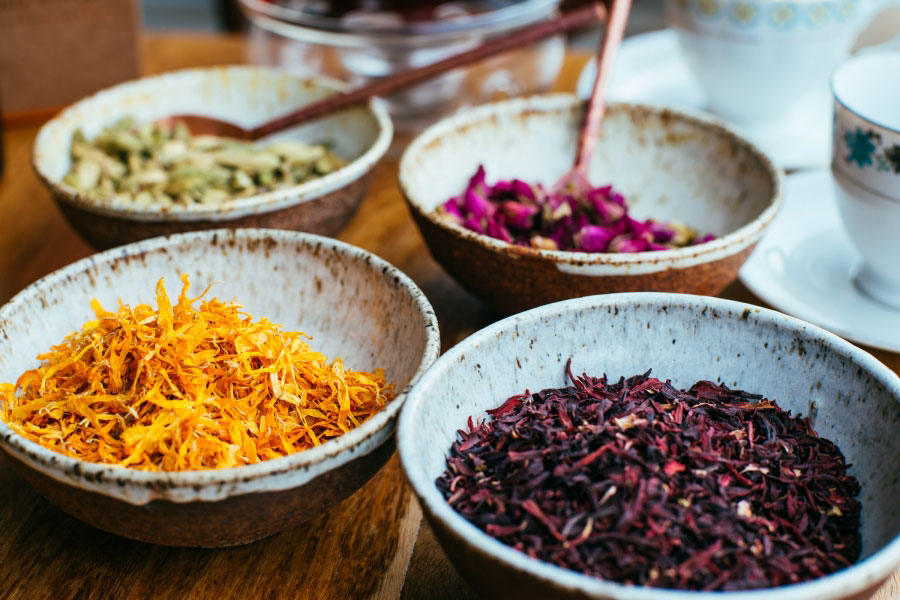The 6 tastes: A Guide Map to Ultimate Nutrition
Much of the wisdom of Ayurvedic nutrition rests on the tip of your tongue, literally!
According to Ayurveda, the sense of taste is a guide map towards proper nutrition as food speaks to us directly through taste.
Rasa – Taste
Ra means ‘to relish, praise or taste;’ sa means ‘juice, sap or secretion.” Rasa is the taste associated with secretions in the mouth. The moment a substance (food, medicine, or herb) touches the tongue, the first experience is taste, or rasa. Any substance, be it chilli or milk, creates salivation and thereby taste.
Ayurveda identifies 6 Tastes by which all foods can be categorised: Sweet, Sour, Salty, Bitter, Pungent, and Astringent.
While the first four tastes are easily recognisable, the last two may not seem familiar. Pungent taste is hot and spicy as found in a chili, while Astringent taste is dry and light as found in an unripe banana, popcorn and legumes.
Ayurveda recommends including each of the tastes in every meal. The belief is that incorporating all six tastes in your meals and adjusting the amounts to your personal constitution will help you maintain balanced nutrition and good health, and feel satisfied overall. The knowledge of the 6 tastes is key to self healing because as we tune into the tastes desired by the body, we tap into the body innate wisdoms regarding food and nutrition.
The 6 Tastes and The Doshas
According to Ayurveda, every substance found in nature is made up of some combination of the 5 basic elements; space, air, fire, water and earth. The same elements that make up the Doshas. Therefore each taste has an effect on Vata, Pitta and Kapha.
When your doshas are out of balance which is seen as ill health in Ayurveda and manifests as symptoms or disease, these 6 tastes can help your restore inner harmony.
The fire, air and ether elements are light and tend to move upward, producing lightness. Conversely, earth and water elements are heavy and move downward, producing heaviness.
|
Taste |
|
Primary Actions |
|
Common Sources |
|
|
|
|||
|
Sweet |
|
Builds tissues, calms nerves |
|
Fruit, grains, natural sugars, milk |
|
Sour |
|
Cleanses tissues, increases absorption of minerals |
|
Sour fruits, yogurt, fermented foods |
|
Salty |
|
Improves taste to food, lubricates tissues, stimulates digestion |
|
Natural salts, sea vegetables |
|
Bitter |
|
Detoxifies and lightens tissues |
|
Dark leafy greens, herbs and spices |
|
Pungent |
|
Stimulates digestion and metabolism |
|
Chili, garlic, herbs and spices |
|
Astringent |
|
Absorbs water, tightens tissues, dries fats |
|
Legumes, raw fruits and vegetables, herbs |
How to use the Knowledge of the 6 Tastes
1. Include all 6 tastes in each meal
Each taste feeds our mind, body, senses, and spirit in its own unique way. Each substances unique combination of attributes will influence its actions in the body. Taste can have a long-standing effect on the doshas, creating either therapeutic or unbalancing actions on body.
Each taste also has a psychological component, creating positive or negative influence, which becomes apparent with frequent usage.
From a modern nutritional perspective, the 6 tastes satisfy each of the macronutrients – the major dietary building blocks. Sweet foods, are rich in fats, proteins, carbohydrates, and water, whereas Bitter and Astringent foods are high in vitamins and minerals. By incorporating all 6 Tastes into each meal, we ensure that energy the body requires is adequately met, thus avoiding food cravings or the over-consumption of certain foods which can lead to many health conditions.
Including the 6 tastes in each meal doesn’t need to be a daunting task. It could be adding a squeeze of lemon to cooked dishes to quickly satisfy the Sour taste, while adding a side of fresh greens will fulfil the Bitter and Astringent tastes.
If we arrange our plate with 1/2 vegetables, 1/4 wholegrain, 1/4 protein (vegetarian or lean meat) with an addition of a good fats, herbs and spices, we can adequately achieve all 6 tastes.
2. Allow your unique constitution (dohsa) to determine the proportion of tastes you eat
Ayurvedic nutrition recommends including all 6 tastes in each meal, while favouring those tastes that bring greater balance to your particular constitution (mind body type). For example, a Pitta individual, will favour cooling foods and spices such as dark leafy greens, mint and coriander, which are high in Bitter and Astringent tastes, while requiring a smaller quantity of the Pungent taste – chilli, alcohol. This helps to offset Pitta’s potential for ‘heat’ conditions such as inflammation and acidity.
Vata individuals are naturally drawn to moist grounding foods such as wholegrains, dairy and good fats to calm and nourish the nervous system. While Kapah’s favour light, drying foods to minimise the potential for weight gain, congestion and mucous issues.
When in a state of balance (health) the body naturally desires tastes that balance its doshic makeup and shuns tastes of an aggravating nature. Healthy cravings are related to the response of cellular intelligence to an increased dosha without the formation or ama (toxins). When we start to attune to this, intuitive eating results.
We need to distinguish though if its a healthy desire or an unhealthy craving. Unhealthy cravings are due to increased doshas slowing agni (digestive fire and metabolism), resulting in the production of ama (toxic impurities). This clogs the cell membranes and disturbs cellular intelligence, generating perverted cravings. These should not be satisfied. Over time, as you further your knowledge of Ayurveda and connect to it in the body, this difference will become clear.
Balancing the Doshas Through Taste
|
|
Most Balancing |
|
Most Aggravating |
|
|
|
|
|||
|
Vata |
|
Sweet, Sour, Salty |
|
Bitter, Pungent, Astringent |
|
Pitta |
|
Sweet, Bitter, Astringent |
|
Sour, Salty, Pungent |
|
Kapha |
|
Pungent, Bitter, Astringent |
|
Sweet, Sour, Salty |
The 6 Tastes
Sweet – Madhura
The word madhura means pleasant, charming, beautiful, agreeable, and melodious, as well as sweet. The sweet taste is comprised of water and earth, and is good for balancing Vata and Pitta due to its cooling, heating and oily qualities. It can increase Kapha for this reason – we see this with an excess of sweet foods (sugar, refined carbohydrates) can lead to weight issues, blood sugar imbalances, diabetes, cough, colds and laziness, all Kapha imbalances.
Of the six tastes, sweet is known to be the most grounding and nourishing. When eaten in moderation, it promotes longevity, strength, and healthy bodily fluids and tissues. It enhances the vital essence of life (ojas).
The sweet taste is prominent in foods such as wheat (unprocessed), rice, dairy, cereals, dates, pumpkins, maple syrup, and licorice root.
Sour – Amla
The sour taste consists of water and fire elements. Amla means sour, acidic and that which easily ferments. Its decreases Vata but increases Pitta and Kapha.
Sour foods include foods like sour cream, yoghurt, vinegar, cheese, citrus fruits and fermented foods like wine.
Sour stimulates appetite and saliva production, and is balancing in its light, heating, and oily properties. The sour taste enlivens the mind, thoughts and emotions and brings appreciation, discrimination and enhances attention span. It can improve appetite, digestion, and elimination. It needs to be eaten in moderation because if you eat it in excess, it can aggravate Pitta and lead to hyperacidity.
Salty – Lavana
Water and fire elements predominate in this taste. Salty taste is heating, heavy, oily and hydrophilic in nature. When used moderately it relieves Vata because of its grounding and hydrating nature, but increases Kapha and Pitta.
Salt adds taste to foods, stimulates digestion, helps electrolyte balance, cleanses tissues and increases absorption of minerals. It enhances spirit, confidence and courage. However, excessive salt leads to sodium retention, makes the blood thick and causes narrowing of the blood vessels which increases blood pressure.
Examples of salty foods are sea vegetables, sea salt, tamari, black olives, Himalayan salt, rock salt, and processed foods (not an ideal or recommended source of salt).
Pungent – Katu
Contains fire and air. Its light, drying and heating in nature. It pacify Kapha but excites Pitta and Vata. This taste is common in spices such as cayenne pepper, chili, black pepper, mustard, ginger and foods like onion and garlic.
When used in moderation it kindles agni, improves digestion and absorption, and cleans the mouth. It also clears the sinuses by stimulating nasal secretion and dissolving Kapha. It improves circulation and breaks up any congestion and fat from the body.
Pungent food may help you think quickly and clearly, and understand complicated matters more easily. Too much pungent food, however, can make you overly critical. Pungent foods will aggravate Pitta quickly and balance Kapha.
Bitter – Tikta
It has the air and ether elements giving it cool, light and dry qualities. It’s considered the coolest and lightest of all the tastes. Because of these qualities, it’s highly detoxifying and can help remove waste products from the body. Bitter foods also help mental purification by freeing you from passions and sultry emotions. Its beneficial for the pancreas and liver, making it supportive to skin conditions and digestion. This makes it best for Pitta, good for Kapha, and least beneficial for Vata.
Bitter foods are turmeric, dandelion, aloe vera, green leafy vegetables, bitter greens such as rocket, endives, raddicho, plus all teas and coffee.
Astringent – Kashaya
Kashaya is derived from the air and earth elements, its cooling, drying and heavy in nature. It reduces Pitta and Kapha, but increases Vata. Unripe banana, pomegranate, chickpeas, green beans, okra, cranberries and raw vegetables are Astringent tasting foods.
The astringent taste has firming qualities which makes it good for absorption and binding of stools – great for diarrhoea. It is anti-inflammatory and decongestant. It aids in wound healing. In excess it creates constipation.
The 6 Tastes and You
As with most things in Ayurveda, the combination of tastes that’s right for you depends a lot on… you! Your constitution, your imbalances, your age, your environment.
Start connecting to the tastes of foods. Each meal sit down and discover what taste is predominant. What do you crave? What makes you feel calm, centred and nourished?
According to Ayurveda, each taste used collectively or individually in the appropriate dose brings about balance of all the bodily systems and yields happiness and good health to all living beings!
Nutrition & Healing at Sukhavati
If you would like to experience the taste sensation of completely balanced meals according to the principals of Ayurvedic nutrition, as well as understand more fully how your unique dohsa can have an influence on what you crave, book yourself in for one of our wellness and transformation programs at Sukhavati’s Wellness Retreat.
With unique Ayurvedic herbal supplements and organic vegetarian cuisine, our Ayurveda wellness programs help mobilise the toxins and impurities stored deep in the body’s tissues, kickstarting its ability to burn fat and achieve balance. Our kitchen team prepare all your meals to ensure you adhere to the strict nutritional guidelines required to achieve peak holistic health during your stay.
For more information or to book an health consultation, please contact rejuvenation@sukhavatibali.com.

Holistic Health Practitioner.



